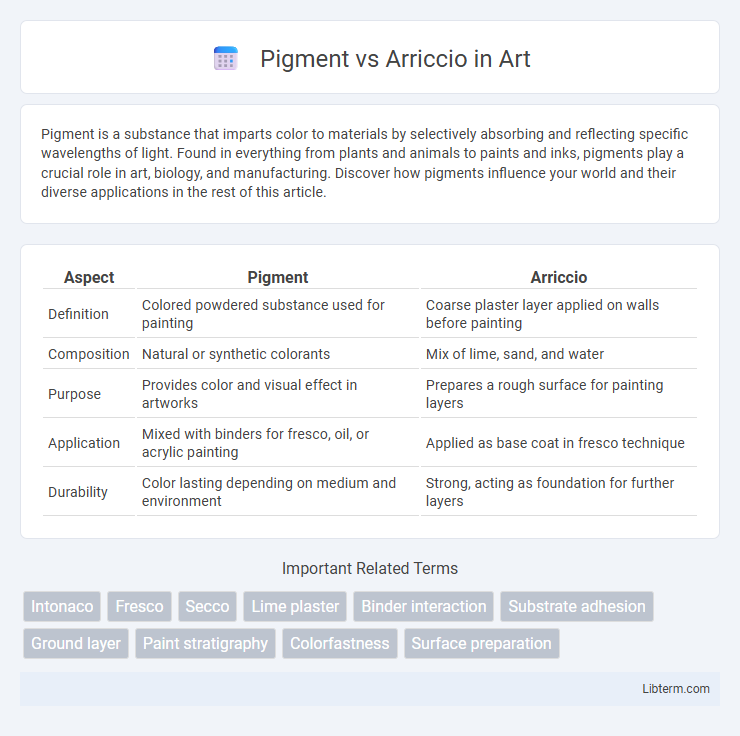Pigment is a substance that imparts color to materials by selectively absorbing and reflecting specific wavelengths of light. Found in everything from plants and animals to paints and inks, pigments play a crucial role in art, biology, and manufacturing. Discover how pigments influence your world and their diverse applications in the rest of this article.
Table of Comparison
| Aspect | Pigment | Arriccio |
|---|---|---|
| Definition | Colored powdered substance used for painting | Coarse plaster layer applied on walls before painting |
| Composition | Natural or synthetic colorants | Mix of lime, sand, and water |
| Purpose | Provides color and visual effect in artworks | Prepares a rough surface for painting layers |
| Application | Mixed with binders for fresco, oil, or acrylic painting | Applied as base coat in fresco technique |
| Durability | Color lasting depending on medium and environment | Strong, acting as foundation for further layers |
Introduction to Pigment and Arriccio
Pigment refers to the finely ground colored particles used in art to create hues and shades when mixed with a binding medium, essential in fresco painting for producing lasting color. Arriccio is the rough first layer of plaster applied to a wall or ceiling as the base for the finer intonaco layer, providing a textured surface to hold subsequent pigment layers securely. Understanding the relationship between pigment and arriccio is crucial in fresco techniques, where pigment is applied onto the intonaco, which sits atop the arriccio for durability and adhesion.
Historical Context: Pigment and Arriccio in Art
Pigment and arriccio play distinct roles in art history, particularly in fresco painting. Pigment refers to the finely ground natural or synthetic particles used for color, while arriccio is the rough first coat of plaster applied to a wall as a base layer to prepare for the intonaco and pigment application. Historically, the quality and composition of arriccio influenced the durability and vibrancy of the pigment, especially in Renaissance frescoes where careful layering enhanced artistic longevity.
Definition and Function of Pigment
Pigment consists of finely ground natural or synthetic particles that provide color to materials by absorbing and reflecting specific wavelengths of light, essential in painting and decoration. Arriccio refers to the rough first coat of plaster applied to a wall or fresco surface, serving as a base layer to which pigments adhere. Pigments are crucial for imparting vibrant and lasting hues during the painting process, while arriccio ensures proper texture and adhesion for subsequent layers.
Understanding Arriccio: Composition and Purpose
Arriccio is a rough plaster layer composed mainly of sand, lime, and sometimes small amounts of water or natural additives, applied as the foundational base in fresco painting. Its primary purpose is to create a textured surface that securely adheres to the wall, providing an ideal ground for the finer intonaco layer where pigments are applied. Unlike pigments, which are finely ground colorants mixed with a binder for artwork, arriccio serves a structural rather than decorative role.
Material Differences: Pigment vs Arriccio
Pigment consists of finely ground natural or synthetic particles used to impart color to a surface, while Arriccio is a rough plaster layer made primarily from lime, sand, and water applied to prepare walls for fresco painting. Pigments are inert colorants mixed into mediums such as lime or oil, whereas Arriccio serves as a structural substrate, providing texture and absorbency for subsequent finer plaster layers. The fundamental distinction lies in pigment's role as a coloring agent and Arriccio's function as a preparatory material composed of mineral-based components.
Application Techniques: Pigment and Arriccio
Pigment refers to the finely ground natural or synthetic color particles mixed with a binder to create paint, applied in thin, pigmented layers for detailed fresco work, while Arriccio is the rough first coat of plaster applied to a wall to provide a stable base for subsequent smoother layers. Application of pigment involves precise brushwork or sponging over the intonaco layer, where pigments chemically bond with wet lime plaster in true fresco technique, ensuring durability and vibrancy. Arriccio application requires a coarse, even spread using trowels to establish texture and adherence, forming the essential groundwork for pigment layers or the smoother intonaco finish.
Role in Fresco Painting
Pigment provides the essential color in fresco painting, applied onto the fresh, wet arriccio layer to ensure proper absorption and durability. Arriccio serves as the rough underlayer of plaster that prepares the wall surface, creating a stable base for the intonaco and pigment application. The interaction between pigment and arriccio is crucial for the fresco's longevity, as the arriccio's texture and moisture regulate pigment fixation and overall color vibrancy.
Durability and Preservation Considerations
Pigment particles, when combined with a stable binder, create a durable color layer vulnerable to environmental factors like moisture and UV exposure, influencing long-term preservation. Arriccio, the rough underlayer of plaster in fresco painting, provides structural support and absorbs pigments, but its porosity affects moisture retention, which can lead to deterioration if not properly managed. Preservation efforts prioritize controlling humidity and temperature fluctuations to maintain pigment vibrancy and prevent arriccio degradation, ensuring the longevity of fresco artworks.
Common Mistakes in Using Pigment and Arriccio
Common mistakes in using pigment and arriccio often involve improper mixing ratios, leading to weak adhesion or discoloration in fresco painting. Pigment is sometimes applied directly onto the arriccio layer without proper preparation, causing poor pigment absorption and uneven color distribution. Neglecting to allow the arriccio to dry sufficiently before applying pigment results in cracking or peeling of the fresco surface.
Conclusion: Choosing Between Pigment and Arriccio
Choosing between pigment and arriccio depends on the intended use and desired durability in fresco painting. Pigments provide vibrant color essential for artistic expression, while arriccio serves as the rough base layer that ensures proper adhesion and structural integrity of the plaster surface. Optimal fresco results are achieved by applying pigment onto a well-prepared arriccio layer, balancing both materials' functions in the fresco technique.
Pigment Infographic

 libterm.com
libterm.com